- pH:
- Temp:
- KH:
- GH:
- NH4:
- NO2:
- NO3:
- PO4:
- Iron:
- Dosing: 10 mL Flourish, 20 mL Excel, 10 ppm NO3, 1 ppm PO4
- NO3:PO4 Cumulative Dosing Ratio: 25:2.8 = 8.9
Notes:
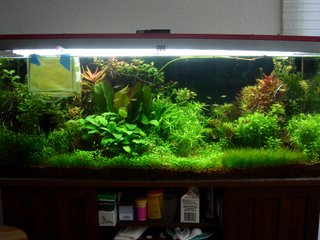
 To construct the hatchery, I sawed off the bottom of two 2L soda bottles. I drilled a hole in each of the soda caps, and glued in an airline connector into each hole using plumber's goop as the glue. I then connected airlines to t-line connectors, shutoff valves and an air pump and hooked the airlines to the airline connectors in the soda caps. I turned the soda bottles upside down and used the bottom halves of two more sawed off soda bottles as stands. Using the shutoff valves, I can control the flow of air from the air pump to either of the bottles. While the eggs are incubating, the air from the air pump helps keep the eggs circulating in the water.
To construct the hatchery, I sawed off the bottom of two 2L soda bottles. I drilled a hole in each of the soda caps, and glued in an airline connector into each hole using plumber's goop as the glue. I then connected airlines to t-line connectors, shutoff valves and an air pump and hooked the airlines to the airline connectors in the soda caps. I turned the soda bottles upside down and used the bottom halves of two more sawed off soda bottles as stands. Using the shutoff valves, I can control the flow of air from the air pump to either of the bottles. While the eggs are incubating, the air from the air pump helps keep the eggs circulating in the water.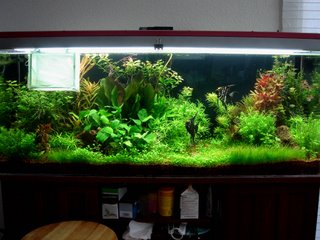


 In the morning, when I removed the filter bag covering the angelfish eggs, there was a bit of fungus on the eggs, which the mother angelfish promptly cleaned. There's currently a heat wave in my area, so the tank is pretty warm, about 84 degrees. I think because it's been so warm, by the afternoon, I could already see tails of the angelfish fry wriggling out of some of the eggs. I noticed that some of the eggs were moved to another small leaf. The angelfish kept picking at the leaf, and when the eggs would come loose, they would mouth the eggs and try to redeposit them. The leaf was too small to hold the eggs, so the eggs would fall off again. They kept doing this over and over again, until I decided to remove those eggs. I moved those eggs on the small leaf to the breeding cage to see if they would survive without the care of the fish, but I left the other eggs on the sword leaf with the parents.
In the morning, when I removed the filter bag covering the angelfish eggs, there was a bit of fungus on the eggs, which the mother angelfish promptly cleaned. There's currently a heat wave in my area, so the tank is pretty warm, about 84 degrees. I think because it's been so warm, by the afternoon, I could already see tails of the angelfish fry wriggling out of some of the eggs. I noticed that some of the eggs were moved to another small leaf. The angelfish kept picking at the leaf, and when the eggs would come loose, they would mouth the eggs and try to redeposit them. The leaf was too small to hold the eggs, so the eggs would fall off again. They kept doing this over and over again, until I decided to remove those eggs. I moved those eggs on the small leaf to the breeding cage to see if they would survive without the care of the fish, but I left the other eggs on the sword leaf with the parents.

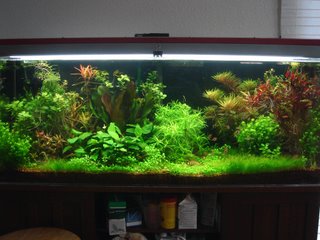
 I traded in the two Kleiner Bar sword plantlets and some stargrass prunings for some Ludwigia palustris at an LFS. I was confused and thought that I was getting some Ludwigia peruensis, I'm not very good at remembering names... The leaves on the palustris look narrower than what I've seen in pictures on the Internet.
I traded in the two Kleiner Bar sword plantlets and some stargrass prunings for some Ludwigia palustris at an LFS. I was confused and thought that I was getting some Ludwigia peruensis, I'm not very good at remembering names... The leaves on the palustris look narrower than what I've seen in pictures on the Internet.
 Those little water bugs also seem to be multiplying. They are swimming in the tank now. None of the fish seem interested in eating them. The harlequin rasboras will mouth them and spit them back out. I noticed that whenever I pour the Melafix into the tank, it gets sucked up into the AquaClear filter and kills some of the bugs in the filter, and the dead bugs then get poured out of the filter output.
Those little water bugs also seem to be multiplying. They are swimming in the tank now. None of the fish seem interested in eating them. The harlequin rasboras will mouth them and spit them back out. I noticed that whenever I pour the Melafix into the tank, it gets sucked up into the AquaClear filter and kills some of the bugs in the filter, and the dead bugs then get poured out of the filter output.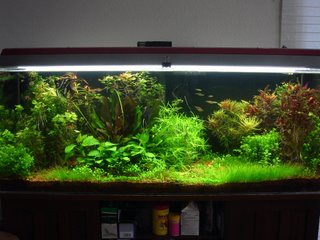
 The Rotala indica and Ammania plants are noticeably less red this week. It seems that either the extra calcium or perhaps just increase in general hardness may affect the coloration somehow. Perhaps all the Cl- ions being added from the CaCl2 are negatively affecting the plants? Or perhaps the extra Ca/hardness is affecting uptake of some other element(s) that would help with the coloration. You can see on the picture to the left that I've never been able to get the L. repens very red. Another difference last week is that I did not dose iron chelate last week till just before the water change, so that might have been a factor, though I am only dosing half of the usual daily dose (0.25 ppm iron versus 0.5 ppm).
The Rotala indica and Ammania plants are noticeably less red this week. It seems that either the extra calcium or perhaps just increase in general hardness may affect the coloration somehow. Perhaps all the Cl- ions being added from the CaCl2 are negatively affecting the plants? Or perhaps the extra Ca/hardness is affecting uptake of some other element(s) that would help with the coloration. You can see on the picture to the left that I've never been able to get the L. repens very red. Another difference last week is that I did not dose iron chelate last week till just before the water change, so that might have been a factor, though I am only dosing half of the usual daily dose (0.25 ppm iron versus 0.5 ppm). A few of leaves of the A. reineckii have been turning transparent, a few stalks of the hairgrass has been turning yellow, some of the leaves of the stargrass are developing some black patches, and there are some transparent patches on the H. micranthemoides leaves. The reineckii leaves turn transparent when it seems that there is not enough magnesium. Even though I've added 1.5 tsp Mg this week, I added another 0.5 tsp today. The algae levels have greatly decreased, more than last week. Perhaps whatever the slight deficiency is showing in these plants is also helping to reduce the algae levels beyond the effects of Excel.
A few of leaves of the A. reineckii have been turning transparent, a few stalks of the hairgrass has been turning yellow, some of the leaves of the stargrass are developing some black patches, and there are some transparent patches on the H. micranthemoides leaves. The reineckii leaves turn transparent when it seems that there is not enough magnesium. Even though I've added 1.5 tsp Mg this week, I added another 0.5 tsp today. The algae levels have greatly decreased, more than last week. Perhaps whatever the slight deficiency is showing in these plants is also helping to reduce the algae levels beyond the effects of Excel.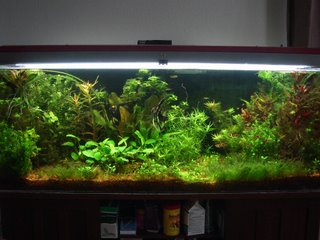
 After using Excel for about 2 weeks. The hairgrass is almost completely clean. The algae is gone from the Kleiner Bar sword. Everything looks much brighter because the algae is no longer covering the leaves. About 75% of the algae is gone, so far.
After using Excel for about 2 weeks. The hairgrass is almost completely clean. The algae is gone from the Kleiner Bar sword. Everything looks much brighter because the algae is no longer covering the leaves. About 75% of the algae is gone, so far.